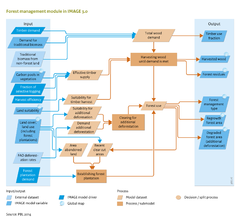Forest management/Description: Difference between revisions
Jump to navigation
Jump to search
No edit summary |
No edit summary |
||
| Line 1: | Line 1: | ||
{{ComponentDescriptionTemplate|Flowchart=ForestManagementModel.png | {{ComponentDescriptionTemplate | ||
|Description==== Timber demand === | |||
In IMAGE 3.0, the extent of forest harvest is driven by timber demand per region. This timber demand is the sum of domestic/regional demand and timber claims by other regions (= export/trade). Trade assumptions for sawlogs and paper/pulp wood are adopted from external models, such as EFI-GTM {Kallio, 2004 #1004}, where for fuel wood they are based on the TIMER model. | |||
=== Timber supply === | |||
In the model, felling in a region continues, until the timber demand has been met, using a stepwise procedure to attribute shares of the total demand to different management systems. First, the demand for timber will be met by the wood harvested in forests that have been converted to agriculture. Second, mature forest plantations (which are at the end of their rotation cycle) within that region can be harvested. The regional establishment of such plantations is scenario driven (see also Table 4.2.2.1). If the timber harvested from these plantations is still insufficient to meet the timber demand, trees from natural forests are harvested, applying either clearcut or selective cut. | |||
=== Forest management types === | |||
The share of each management system was derived from forest inventories taken for different world region (Arets et al., 2011), and used as model input (Table 4.2.2.1). Under selective cut, only a fraction of the trees (and thus stems and other tree pools) is logged (fraction is regional and time specific). The other trees remain in the forest. After logging only a fraction of the harvested wood can actually become removed (=fraction take away). Also this fraction is given by input/is scenario driven, i.e. regional specified and can vary over time (Table 4.2.2.1). In addition it depends on the overall wood demand (it equals 1 for wood fuel and the default value to industrial round wood). What is left behind in the forest represents losses/residues during tree harvesting (from tree damage and unusable tree parts) or left in the forest by purpose because of environmental concerns (e.g. biodiversity and nutrient supply). Trees can only be harvested in any forest management type once the rotation cycle of forest regrowth has been completed (Table 4.2.2.1). | |||
=== Fuel Wood === | |||
Part of the global energy demand is met by fuel wood, depending on the world region. Some of the fuel wood is harvested through formal forestry activities and can be coupled to the management systems described above. In addition, fuel wood is produced and collected from non-forest areas; for example, from thinning orchards and along roadsides (FAO, 2001; FAO, 2008). Reliable data on fuel wood production are scarce; therefore, assumptions have been made in IMAGE3.0. For the developed regions, it is assumed that fuel wood is produced on a large scale and, therefore, in IMAGE, all fuel wood demand is added to timber demand. In the transitional regions as well as in the developing regions, smaller fractions of the fuel wood demand are assumed to be met from forestry operations: 50% and 32%. | |||
=== Establishing new plantations === | |||
Forest plantations are established with the purpose of growing wood in an efficient way. The expectation is that, in the future, more and more wood will be produced on plantations, as sustainability criteria may complicate the harvest from natural forests (Form, 2013). For this purpose, plantation planting rate scenarios have constructed by the FAO (Brown 2000; Carle and Holmgren 2008). In the IMAGE 3.0 model, forest plantations are assumed firstly to be established on abandoned agricultural land. Only when there is not enough abandoned land available forest plantations will be established on cleared forest areas. Once a forest plantation has been established, the land cannot be used for other purposes or be changed back to natural vegetation until the trees’ rotation cycle has been completed. | |||
=== Additional Deforestation === | |||
As aforementioned, land-use change is the major driver of global forest clearing. Apart from this process, however, there are also other causes of deforestation, not related to changes in food demand. In order for IMAGE 3.0 to be consistent with the deforestation rates per world region as reported by the FAO (2010), the category ‘additional deforestation’ has been introduced in the model, as an additional type of forest use. | |||
The wood from forests cleared as a result of ‘additional deforestation’ is not used to fulfil the timber demand. Instead, in certain regions, mainly at higher latitudes, the wood is simply left behind; in other -more tropical- regions it is burnt. The model assumes no recovery of natural vegetation for these areas, and no agricultural activities. In the model, additional deforestation for any particular region is allocated only after the timber demand has been met. | |||
|Flowchart=ForestManagementModel.png | |||
|AltText=Component flow chart forest management | |AltText=Component flow chart forest management | ||
|CaptionText=Flow diagram of forest management | |CaptionText=Flow diagram of forest management | ||
|ExternalModel=EFIGTM | |ExternalModel=EFIGTM | ||
}} | }} | ||
Revision as of 16:09, 25 March 2014
Parts of Forest management/Description
| Component is implemented in: |
| Components: |
| Related IMAGE components |
| Projects/Applications |
| Key publications |
| References |
